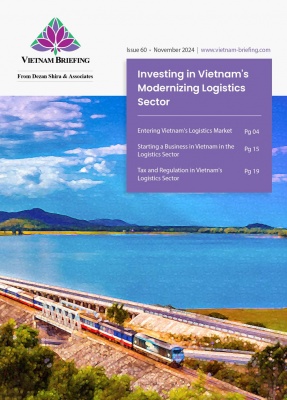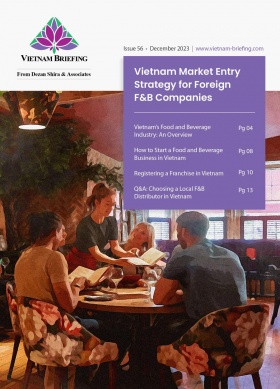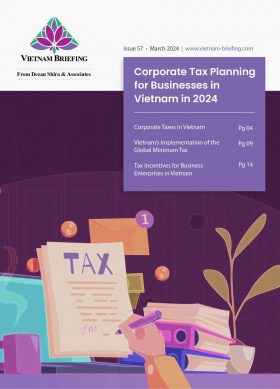Vietnam’s Economic Performance in H1 2024: Key Indicators and Growth Forecast
Vietnam showcased strong performances across multiple indicators in the first half of 2024, prompting the General Statistics Office (GSO) to project a 6-6.5 percent growth rate for the year, aligning with the government’s target.
According to the GSO, Vietnam experienced a 6.42 percent growth in gross domestic product (GDP) year-on-year in H1 2024, slightly lower than the 6.58 percent reported during the same period in 2022. The GSO attributed Vietnam’s strong economic performance to the resilience of the global economy despite uncertainties and volatilities.
Below we discuss Vietnam’s economic data for H1 2024 and growth projections to the end of the year.
Vietnam GDP and growth projections for 2024
The United Overseas Bank (UOB), The Asian Development Bank, Standard Chartered, and HSBC have all maintained their growth forecasts for Vietnam at 6 percent for 2024. In June, a team from the International Monetary Fund (IMF) led by Paulo Medas noted that Vietnam’s economy had rebounded and grew by 6.4 percent year-on-year in H1.
Meanwhile, in a July ASEAN+3 regional outlook report, AMRO revised its GDP growth forecast for Vietnam upward to 6.3 percent from 6 percent in its April report while maintaining a 6.5 percent increase for the 2025 projection.
During the government’s regular press briefing in Hanoi on July 6, Deputy Minister of Planning and Investment Tran Quoc Phuong stated that registered foreign direct investment (FDI) is expected to reach US$40 billion this year.
The Central Institute for Economic Management (CIEM), under the Ministry of Planning and Investment (MPI), recently reported that real GDP growth had exceeded its potential for four consecutive quarters. CIEM projected two scenarios for this year’s GDP growth:
- In the normal scenario, GDP is expected to reach 6.55 percent, inflation at 4.32 percent, and export growth at 9.54 percent.
- In a more positive scenario, GDP could expand by nearly 7 percent, with average inflation lower at 4.12 percent, and export growth exceeding 11.64 percent.
Investments
FDI
According to the GSO, FDI inflows into Vietnam reached nearly US$15.2 billion during the first six months of 2024, marking a 13.1 percent annual increase.
As of June 20, 2024, foreign investors had registered about US$9.54 billion in 1,538 new projects, reflecting a 47 percent rise in capital and a 19 percent increase in the number of projects compared to last year. Additionally, they spent US$3.95 billion in additional capital and US$1.698 billion on capital contributions and share purchases.
During the same period, Vietnam recorded US$10.842 billion in disbursed capital, an 8.2 percent annual increase and the highest record over the past five years.
In terms of investment by countries/regions, Singapore led the list of Vietnam’s most prominent investors with a total capital of US$5.579 billion, accounting for 36.74 percent of the total FDI inflow. Japan followed in second place with US$1.731 billion, representing 11.399 percent of the total. Hong Kong (China) was close behind with US$1.730 billion in investments, making up 11.393 percent. South Korea and China followed with investments of US$1.411 billion and US$1.299 billion, respectively, contributing 9.292 percent and 8.554 percent.
Public investments
Experts have observed stagnation in the disbursement of public investment funds. Allocated capital remains idle, with several ministries and departments yet to disburse their funds. Further, total public investment resources in 2024 are already lower than last year.
Vietnam had one IPO in H1 2024
According to global consultancy Deloitte, Vietnam had only one initial public offering (IPO) in the first half of this year. DNSE Securities JSC listed on the Ho Chi Minh Stock Exchange (HoSE), raising US$36.9 million for an IPO market capitalization of US$135 million. This single listing surpassed the market performance of the three IPOs in 2023, which collectively raised around US$7 million.
Vietnam’s new stock trading system, KRX, is scheduled to launch in September 2024, a delay from the initial plan.
Trade
From January to June 2024, Vietnam recorded export revenues of US$190.08 billion, a 14.5 percent increase year-on-year, while import expenditures rose 17 percent to US$178.45 billion. This resulted in a trade surplus of US$11.63 billion, lower than the US$13.4 billion recorded in the first half of 2023.
In particular, the FDI sector posted export revenues of US$136.69 billion, increasing 12.3 percent year-over-year, while import expenditures rose 14.1 percent to US$112.71 billion, resulting in a US$23.98 billion trade surplus.
Conversely, the domestic sector experienced a US$12.35 billion trade deficit.
|
Vietnam’s Key Export and Import Sectors in H1 2024 |
||
|
Categories |
Values (US$ billion) |
Performance compared to 2023 (%) |
|
Export |
||
|
Electronics, computers, and components |
32.91 |
28.6 |
|
Phones and components |
27.2 |
11.3 |
|
Machinery and equipment |
22.93 |
16.2 |
|
Apparel and textiles |
16.28 |
3.1 |
|
Footwear |
10.84 |
10 |
|
Import |
||
|
Electronics, computers, and components |
48.84 |
26.7 |
|
Machinery and equipment |
22.31 |
14.6 |
|
Fabric |
7.12 |
10.8 |
|
Steel-iron |
5.05 |
24 |
|
Plastics |
5.36 |
14.7 |
|
Vietnam’s Export Revenue and Import Expenditure in H1 2024 |
||
|
Categories |
Values (US$ billion) |
Proportion (%) |
|
Export revenue |
||
|
Manufacturing and processing |
166.79 |
87.7 |
|
Farm produce and forestry goods |
16.64 |
8.8 |
|
Fisheries |
4.36 |
2.3 |
|
Fuel and natural resources |
2.29 |
1.2 |
|
Import expenditure |
||
|
Materials for production |
167.73 |
94 |
|
Consumer goods |
10.72 |
6 |
Key trade partners
China was Vietnam’s biggest trade partner in H1 2024, with a total trade value of US$94.8 billion, followed by the U.S. at US$61.4 billion and the ASEAN bloc at US$40.8 billion. China was also Vietnam’s largest import market, while the U.S. was its most prominent export destination.
Specifically, Vietnam spent US$67 billion on imports from China, a 34.7 percent year-over-year increase, and earned US$27.8 billion from exports to China, a 5.3 percent increase.
Vietnam’s exports to the U.S. rose 22.1 percent year-over-year to US$54.3 billion, while imports from the U.S. increased by 2.8 percent to US$7.1 billion.
Other major trade partners of Vietnam included South Korea, the EU, and Japan, with total trade values reaching US$38.4 billion, US$32 billion, and US$21.7 billion, respectively.
Industries
The added value of industrial production grew by 7.54 percent from the first half of 2023 to the same period this year.
The manufacturing and processing sector remained the primary driver of overall economic growth. The S&P Global Vietnam Manufacturing Purchasing Manager’s Index (PMI) surged to 54.7 in June 2024 from 50.3 a month earlier, signaling strengthened business conditions and marking a third consecutive month of growth.
Simultaneously, the GSO reported that 56 industries recorded an increase in the Industrial Production Index (IIP), although seven industries experienced otherwise. In a separate report dated June 19, the World Bank (WB) noted a 2.6 percent month-on-month increase in Vietnam’s IIP for May.
However, the surge in new orders created immense pressure on operating capacity, causing workloads to pile up more noticeably for the second time in three months.
Meanwhile, statistics indicate that growth rates in specific service sectors, including wholesale and retail, automobile and motorcycle repair, and finance and banking, were less robust compared to H1 2023.
Employment
The GSO estimated Vietnam’s unemployment rate was 2.27 percent in the first six months of 2024, consistent with the same period last year. The agency also assessed the urban and rural unemployment rates to be at 2.68 and 2 percent, respectively.
The unemployment rate among the 15-to-24 age group is estimated to have risen to 8 percent, an increase of 0.49 percentage points from H1 2023. The annual rate for 2024 is estimated to be 8.02 percent in 2024, an increase of 0.6 percentage points from the previous year.
As of the end of June, Vietnam’s workforce aged 15 and above is estimated at 52.5 million people, up 196,600 year-on-year. This figure includes 27.86 million males and 24.6 million females, with increases of 110,100 and 86,500 year-on-year, respectively. Approximately 51.4 million people aged 15 or older were employed in H1 2024.
The service sectors dominated the country’s workforce, employing 20.7 million workers (40.2 percent), followed by industry and construction with 17 million (33.1 percent), and agriculture-forestry-fisheries with 13.7 million (26.7 percent).
Labor income
According to the GSO, in H1 2024, the average monthly income of contracted workers was approximately VND7.5 million (US$295), which increased by VND519,000 (US$20.4) year-on-year.
Vietnamese male workers with labor contracts earned an average monthly income of VND8.5 million (US$334), while their female counterparts earned about VND6.4 million (US$251.4). In urban areas, the average monthly income was VND9.1 million (US$357), whereas in rural areas, it was VND6.5 million (US$255).
Inflation
Experts highlight that Vietnam’s economy is facing significant pressure, particularly evident in several key macroeconomic indicators, with inflation being particularly noteworthy. Core inflation rose by 2.75 percent, while the average Consumer Price Index (CPI) increased by 4.08 percent in H1 2024 compared to the same period last year, surpassing the lower end of the annual target range of 4-4.5 percent. The CPI has shown a consistent monthly upward trend.
Inflation is expected to continue rising due to supply fluctuations, global price volatility, and increased demand for electricity and services like transportation and tourism during the peak summer season. Wage increases that took effect from July 1, along with anticipated adjustments in prices of state-controlled items such as electricity, medical services, and education, are also likely contributors to inflationary pressures.
Domestic consumption has shown some improvement but has fallen short of expectations. The total value of retail sales and consumer service revenue (excluding price factors) increased by only 5.7 percent over the past six months, significantly below anticipated levels.
What businesses should pay attention to
Despite positive developments across various aspects, Vietnam’s economy faces latent risks that could impact businesses adversely. These include potential currency depreciation and the recent rise in public wages, necessitating vigilant oversight and responsive measures from the State Bank of Vietnam (SBV) to manage these risks effectively.
Enterprises also encounter ongoing challenges such as persistent issues in the business environment, constraints in accessing capital, and elevated input costs amid a competitive output market landscape.
Experts recommend that businesses and industries take proactive measures to mitigate potential negative impacts:
- Monitor production and business conditions closely to preempt emerging risks. This involves advocating for policies that remove barriers and allocate resources effectively to businesses and production facilities, particularly in processing, manufacturing, and market services.
- Strengthen linkages between production and distribution channels. This approach would benefit from efficient public investment disbursement, crucial for meeting targets and supporting other economic sectors.
- Innovate trade promotion strategies to leverage market recovery trends and capitalize on export opportunities.
The National Assembly has extended a 2 percent reduction in value-added tax (VAT) on selected goods and services until the year’s end to stimulate demand. Some proponents advocate extending this policy until the end of 2025 and implementing deeper VAT cuts to further encourage consumer spending.
About Us
Vietnam Briefing is published by Asia Briefing, a subsidiary of Dezan Shira & Associates. We produce material for foreign investors throughout Asia, including ASEAN, China, and India. For editorial matters, contact us here and for a complimentary subscription to our products, please click here. For assistance with investments into Vietnam, please contact us at vietnam@dezshira.com or visit us at www.dezshira.com.
Dezan Shira & Associates assists foreign investors throughout Asia from offices across the world, including in Hanoi, Ho Chi Minh City, and Da Nang. We also maintain offices or have alliance partners assisting foreign investors in China, Hong Kong SAR, Dubai (UAE), Indonesia, Singapore, Philippines, Malaysia, Thailand, Bangladesh, Italy, Germany, the United States, and Australia.
- Previous Article Vietnam-South Korea Trade and Investment
- Next Article EuroCham Vietnam’s Business Confidence Index for Q2 2024































